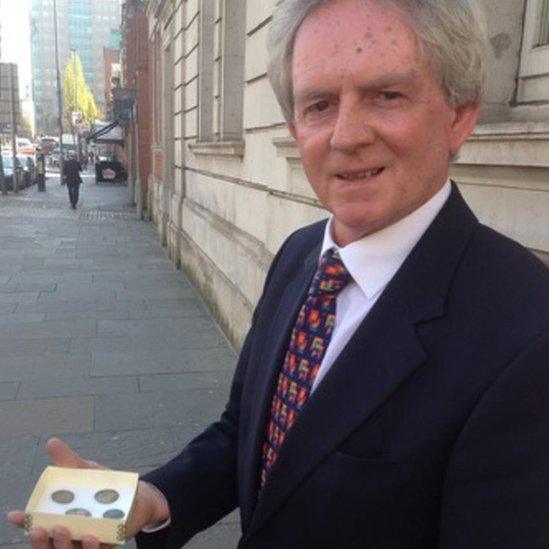14th Century coins found in Banbridge field declared to be treasure by inquest
- Published

Keen metal detector Tom Crawford discovered the coins beneath soil on farmland near Banbridge, County Down, last year
Four silver coins dating from the 14th Century that were found on County Down farmland have been declared to be treasure at an inquest in Belfast.
The coins, which are known as Scottish groats, were discovered by keen metal detector Tom Crawford last January.
They were buried about eight inches beneath the soil on a farm near Banbridge.
Experts believe they are part of a larger hoard of coins found by Mr Crawford in the same field in 2001.
The collection was probably dispersed over time through ploughing.
This was Mr Crawford's fourth time at a treasure trove inquest.
He said his success was about "knowing where to go" and "having a fair idea of where to look".
"There is more chance of finding something where you know people would have been living 1,000 years ago," he added.
He said discovering long-buried artefacts was a "euphoric" feeling.
"It's not so much the money, it's the fact that you are the first person to touch something in 700 years," he said.
"I found a 3,000-year-old bronze axe about 10 years ago and it's the idea that something has been hidden for so long and then you get to see it and touch it."
Former curator at the Ulster Museum, Robert Heslip, said the hoard of coins was probably buried near a landmark - a small Rath ring fort.
The person who left them may have died before reclaiming them.
'Cluster'
He said finds like this one are significant because they are specific to a particular time and to this part of Northern Ireland.
The coins date back to the 14th century and are known as Scottish groats
"You find virtually nothing like this in the south of Ireland and they peter out in the west," he said.
"There have been a cluster of these sorts of finds in eastern Ulster."
The coins will now be sent to the British Museum in London for valuation.
It is thought they are probably worth between £50 and £100 each.
They will be offered for sale and any profit is split between the finder and the owner of the land where the treasure was uncovered.
- Published22 April 2015